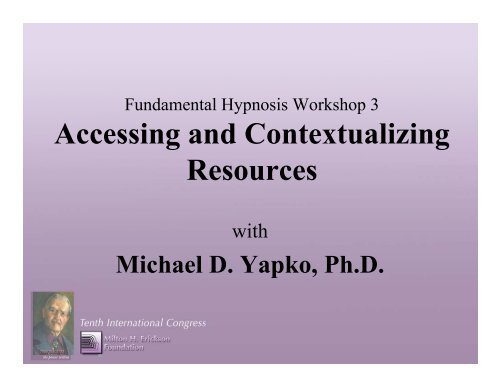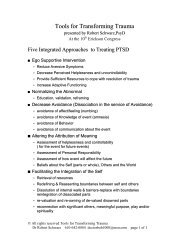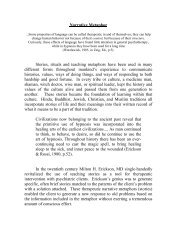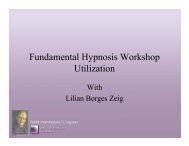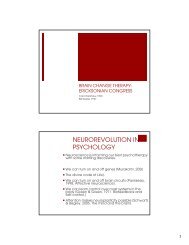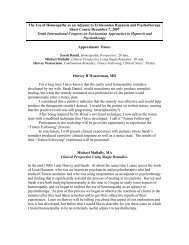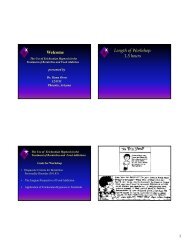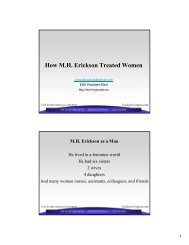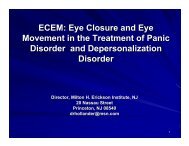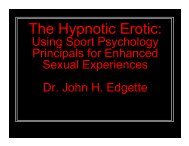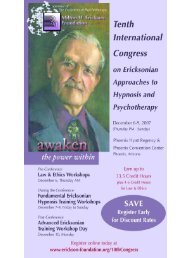Accessing and Contextualizing Resources
Accessing and Contextualizing Resources
Accessing and Contextualizing Resources
Create successful ePaper yourself
Turn your PDF publications into a flip-book with our unique Google optimized e-Paper software.
Fundamental Hypnosis Workshop 3<br />
<strong>Accessing</strong> <strong>and</strong> <strong>Contextualizing</strong><br />
<strong>Resources</strong><br />
with<br />
Michael D. Yapko, Ph.D.
Does Hypnosis Cure People?<br />
NO! It’s what happens DURING hypnosis -<br />
the new <strong>and</strong> beneficial associations the<br />
client forms
Thus, the Salient Question…<br />
Is NOT, “Does hypnosis cure problem X?” Rather,<br />
the salient question is, “If one applies therapy<br />
approach Y without hypnosis <strong>and</strong> applies therapy<br />
approach Y with hypnosis, will the addition of<br />
hypnosis to the process likely enhance the<br />
treatment outcome?”<br />
The evidence suggests the answer is yes<br />
.
Age regression is the most commonly<br />
applied process in the context of<br />
psychotherapy<br />
People routinely report the current problems<br />
are rooted in past experiences
Possible Goals of<br />
Age Regression<br />
• Simple review of experience<br />
• <strong>Accessing</strong> specific resources<br />
• Resolving critical incidents<br />
• Rewriting personal history<br />
• Amplifying differences between then, now <strong>and</strong><br />
later
Are You In or Out<br />
of the Memory?<br />
• If you’re not in the memory, it’s an observer<br />
memory; this is more likely when you’re asking<br />
for objective information<br />
• If you’re in the memory, it’s a field memory;<br />
this is more likely when you’re asking for or<br />
about feelings
Age Regression Structures<br />
• Hypermnesia (Dissociated<br />
regression- reviewing the past from the<br />
present)<br />
• Revivification (Associated regression-<br />
reliving the past as if it is the present)
Age Regression Strategies<br />
• Direct regression to a specific time, context<br />
• Affect or somatic bridging<br />
• Imagery of special vehicles<br />
• Metaphorical <strong>and</strong> indirect approaches<br />
• Gradual regression<br />
• Temporal disorientation (Confusion)<br />
• Age progression <strong>and</strong> regression
<strong>Accessing</strong> And<br />
<strong>Contextualizing</strong> <strong>Resources</strong><br />
An empowering intervention strategy of<br />
empowerment by making dissociated<br />
resources available in desired contexts
Strategy Structure:<br />
<strong>Accessing</strong> <strong>and</strong> <strong>Contextualizing</strong><br />
• Induction procedure<br />
• Build response set regarding memory (orient to<br />
general experience)<br />
• Age regression to a specific context<br />
• Ideomotor signal indicating context retrieved<br />
• Suggestions to facilitate verbalization
Strategy Structure:<br />
<strong>Accessing</strong> <strong>and</strong> <strong>Contextualizing</strong><br />
• Verbal interaction regarding memory<br />
• Identify specific resources in past context<br />
• Consolidate resources<br />
• Orient to future <strong>and</strong> extend resources into desired context<br />
• Post-hypnotic suggestions for integration<br />
• Closure <strong>and</strong> disengagement
Michael D. Yapko, Ph.D.<br />
www.yapko.com<br />
michaelyapko@roadrunner.com


